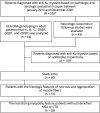Pathologic Features of Anti-Ku Myositis
- PMID: 38547417
- PMCID: PMC11175641
- DOI: 10.1212/WNL.0000000000209268
Pathologic Features of Anti-Ku Myositis
Abstract
Objective: Characteristics of myositis with anti-Ku antibodies are poorly understood. The purpose of this study was to elucidate the pathologic features of myositis associated with anti-Ku antibodies, compared with immune-mediated necrotizing myopathy (IMNM) with anti-signal recognition particle (SRP) and anti-3-hydroxy-3-methylglutaryl-coenzyme A reductase (HMGCR) antibodies, in muscle biopsy-oriented registration cohorts in Japan and Germany.
Methods: We performed a retrospective pathology review of patients with anti-Ku myositis samples diagnosed in the Japanese and German cohorts. We evaluated histologic features and performed HLA phenotyping.
Results: Fifty biopsied muscle samples in the Japanese cohort and 10 in the German cohort were obtained. After exclusion of myositis-specific autoantibodies or other autoimmune connective tissue diseases, 26 samples (43%) of anti-Ku antibody-positive myositis were analyzed. All the samples shared some common features with IMNM, whereas they showed expression of MHC class II and clusters of perivascular inflammatory cells more frequently than the anti-SRP/HMGCR IMNM samples (71% vs 7%/16%; p < 0.005/<0.005; 64% vs 0%/0%; p < 0.005/<0.005). Anti-Ku myositis biopsies could be divided into 2 subgroups based on the extent of necrosis and regeneration. The group with more abundant necrosis and regeneration showed a higher frequency of MHC class II expression and perivascular inflammatory cell clusters. HLA phenotyping in the 44 available patients showed possible associations of HLA-DRB1*03:01, HLA-DRB1*11:01, and HLA-DQB1*03:01 (p = 0.0045, 0.019, and 0.027; odds ratio [OR] 50.2, 4.6, and 2.8; 95% CI 2.6-2942.1, 1.1-14.5, and 1.0-7.0) in the group with less conspicuous necrosis and regeneration. On the contrary, in the group of more abundant necrosis and regeneration, the allele frequencies of HLA-A*24:02, HLA-B*52:01, HLA-C*12:02, and HLA-DRB1*15:02 were lower than those of healthy controls (p = 0.0036, 0.027, 0.016, and 0.026; OR = 0.27, 0, 0, and 0; 95% CI 0.1-0.7, 0-0.8, 0-0.8, and 0-0.8). However, these HLA associations did not remain significant after statistical correction for multiple testing.
Discussion: While anti-Ku myositis shows necrotizing myopathy features, they can be distinguished from anti-SRP/HMGCR IMNM by their MHC class II expression and clusters of perivascular inflammatory cells. The HLA analyses suggest that anti-Ku myositis may have different subsets associated with myopathologic subgroups.
Conflict of interest statement
The authors report no relevant disclosures. Go to
Figures


References
-
- Uruha A. Autoimmune myositis-Mechanism and therapy development. Neurol Clin Neurosci. 2021;10(6):279-288. doi:10.1111/ncn3.12563 - DOI
MeSH terms
Substances
LinkOut - more resources
Full Text Sources
Medical
Research Materials
